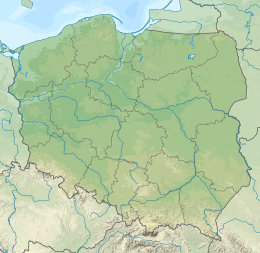Sonnenburg concentration camp
| Sonnenburg concentration camp | |
|---|---|

Murdered prisoners of Sonnenburg concentration camp, 1945, with Soviet military guard
Location of Sonnenburg at Słońsk, Poland
|
|
| Location | Słońsk, Poland |
| Persecution | Imprisonment, forced labor |
Sonnenburg concentration camp (German: Konzentrationslager Sonnenburg) was opened on 3 April 1933 in Sonnenburg (now Słońsk in Poland) near Küstrin (Kostrzyn nad Odrą) in a former Neumark prison, on the initiative of the Free State of Prussia Ministry of the Interior and Justice.
Although the state of hygiene in the building, which had been closed in 1930 was appalling, officials of the Prussian justice ministry recommended it as a suitable site. They estimated the capacity of the building at 941 so-called protective custody prisoners (Schutzhäftlinge), who could be accommodated either in single cells or in communal cells holding up to 20, 30 and 60 people each. The first 200 prisoners along with 60 SA auxiliary police came on 3 April 1933 from the Berlin Police Presidium. Later, on the order of the head of the Prussian Gestapo, prisoners were deported from the penal institution of Gollnow in Pomerania to Sonnenburg, bringing the number of inmates to 1,000.
Sonnenburg concentration camp was closed on 23 April 1934. The prison heritage building still exists. Since the beginning of the Second World War in 1939 the concentration camp or punishment camp (Straflager) continued as a concentration and labour camp for alleged anti-German people from the occupied territories until 1945. Amongst its inmates were the resistance fighters, Jean-Baptiste Lebas and Bjørn Egge. The French spy, René Lefebvre, father of Archbishop Marcel Lefebvre, succumbed in 1944 to the consequences of imprisonment there.
The first commandant was police lieutenant (Polizeioberleutnant) Keßler. After him came:
SA-Sturmführer Bahr initially commanded the infamous Berlin SA storm troops (Stürme) No. 1 Horst Wessel and No. 33 Mordsturm Maikowski, which were responsible for guarding prisoners. They were reinforced by members of the police. In late April, the Berlin SA men were replaced by others from Frankfurt/Oder. At the end of August the SS took over, as they did in many camps, with 150 men from the 27th SS Regiment (SS-Standarte 27) from Frankfurt/Oder.
...
Wikipedia

